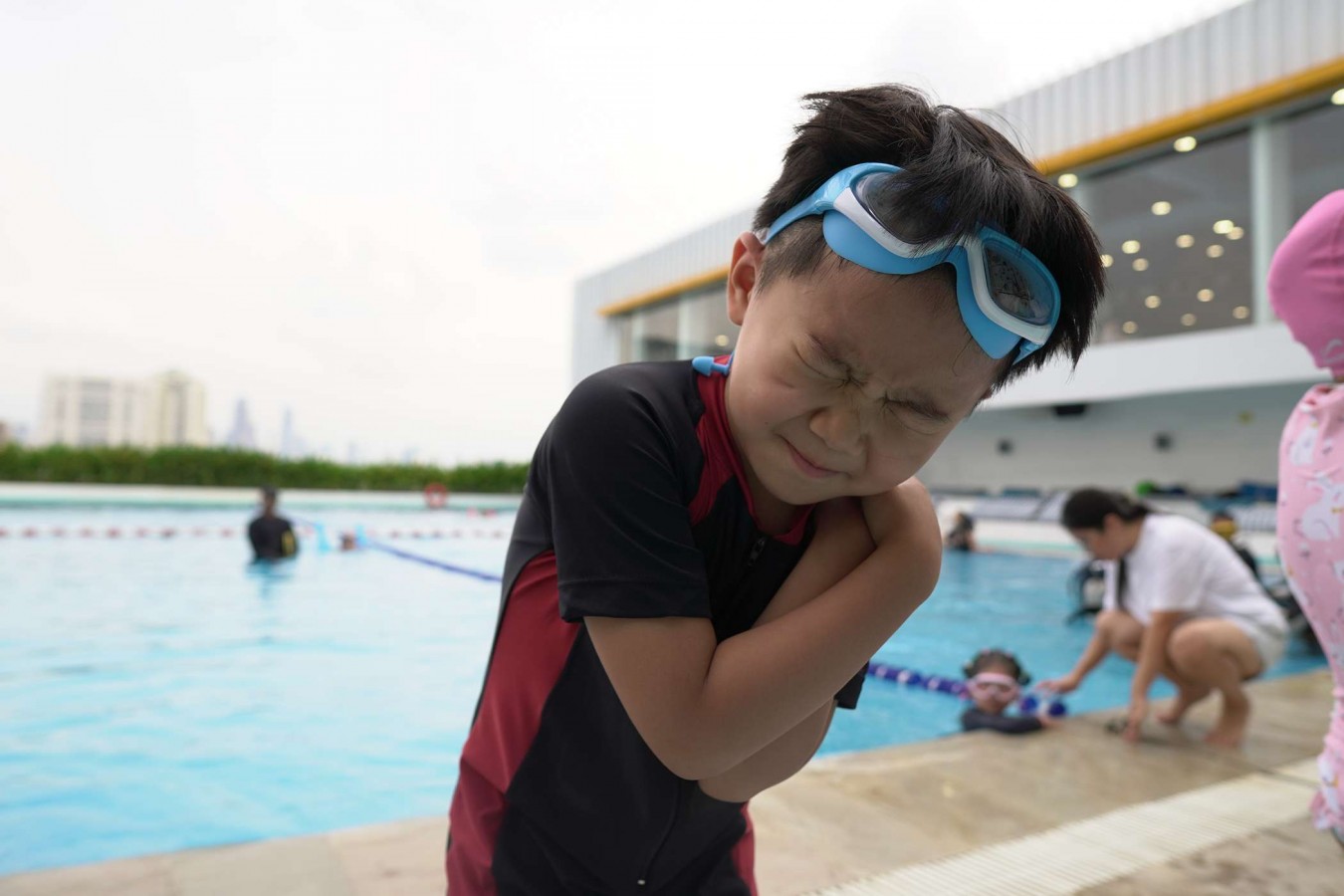Swimmer's Shoulder: Prevention, Treatment, and Cure

Ever heard of “swimmer’s shoulder”? No, it’s not a fancy medal or a new swim stroke. It’s something even the best swimmers dread, which is an annoying, sometimes painful shoulder injury that can sneak up on anyone who loves the water a little too much.
If you are a competitive swimmer chasing milliseconds, a swimmer's shoulder can slow you down. But don’t worry—this guide will break it all down: what it is, why it happens, and how to prevent, treat, and even cure it. Let’s dive right in!
What is a Swimmer's Shoulder?
Swimmer’s shoulder is a common overuse injury that affects the muscles, tendons, and joints around your shoulder. It’s not just one specific issue, but it’s actually an umbrella term for a variety of problems like rotator cuff tendinitis, shoulder impingement syndrome, and bursitis.
These conditions cause pain, inflammation, and discomfort in the front or side of the shoulder (especially during or after swimming).
Common Symptoms:
- Dull or sharp shoulder pain during or after swimming
- Pain when lifting the arm overhead
- Reduced range of motion or stiffness
- Weakness in the shoulder
- Clicking or popping sensation in the joint
The Biomechanics of Swimming: Why Shoulders Work Overtime
Swimming is one of the most shoulder-intensive sports out there. Did you know that the shoulder performs about 90% of the propulsive force in strokes like freestyle, butterfly, and backstroke? That’s a lot of movement and stress!
Here’s a fun breakdown of what your shoulder goes through with each stroke:
A. Freestyle
- Repetitive overhead movement
- Internal rotation while pulling through the water
- Shoulder stabilizers (like the rotator cuff) work hard to control motion
B. Butterfly
- Simultaneous arm movements demand powerful shoulder contractions
- Timing and balance are key, so if your form is off, stress increases
C. Breaststroke
Breastroke has less overhead motion, but sudden outward sweeps can still strain muscles if done incorrectly
D. Backstroke
Continuous rotation and lifting above the head stresses the shoulder joint capsule and tendons
All of these strokes require fluid, controlled, and repetitive arm motions, and when things get out of sync—due to fatigue, poor technique, or overtraining—the shoulder can get cranky. That’s when injuries begin to surface.
What Causes a Swimmer's Shoulder?
Swimmer’s shoulder usually creeps in slowly. Here are the main culprits behind this injury:
1. Poor Technique
Using the wrong body or arm position increases strain. For example, crossing your hand over the centerline during freestyle puts extra stress on the shoulder.
2. Overtraining
Too many laps without enough rest = tired muscles and inflamed tendons. Swimmers sometimes swim 10,000 meters or more a day, and that’s a lot of wear and tear.
3. Muscle Imbalance
When the muscles at the front of the shoulder (like the chest) overpower the muscles at the back (like the rotator cuff or scapular stabilizers), the joint becomes unstable.
4. Lack of Warm-Up or Cool-Down
Jumping straight into the pool without stretching or gradually increasing intensity can catch your shoulders off guard.
5. Weak Core and Poor Posture
Believe it or not, shoulder health is linked to your core and spine! Poor posture or a weak core can disrupt alignment, making the shoulders work harder.
How to Prevent a Swimmer's Shoulder
Now that we know swimmer’s shoulder isn’t just about swimming a lot, but swimming with poor habits, it’s time to talk about prevention. Because let’s be real, nobody wants to sit on the pool deck with an ice pack while their teammates or friends are diving in and having all the fun!
Here are five practical and powerful ways you can protect your shoulders and keep swimming strong.
1. Fix Your Technique
Your stroke technique is like the foundation of a house. If it’s shaky, everything else falls apart. Bad habits in the water can put too much strain on your shoulders.
What to do:
- Get a swim coach or join Private Instructions class so they can watch you or record a video of your stroke. Sometimes you can’t feel the mistake, but you’ll definitely see it.
- Focus on a high elbow recovery, smooth hand entry, and pulling straight back (not under your body).
- In freestyle, make sure your thumb isn’t leading the hand entry. This internal rotation stresses the shoulder joint.
2. Strengthen Supporting Muscles
Swimming works your big muscles like the lats and pecs, but the smaller stabilizers, like the rotator cuff and scapular muscles, often get left behind. If they’re weak, your shoulder becomes unstable.
That’s where dryland training comes in. Just 20–30 minutes, 2–3 times a week, can make a big difference!
3. Don’t Skip Warm-Ups and Cool-Downs
Imagine jumping into a car and flooring the gas without letting the engine warm up. That’s what skipping warm-ups is like for your shoulders.
Before your swim: Do conditioning exercises like:
- Arm circles
- Arm swings
- Shoulder rolls
- Band pull-aparts
These wake up the muscles, increase blood flow, and prepare your joints for action.
After your swim: Switch to static stretches to help your muscles relax and lengthen. Try:
- Cross-body shoulder stretch
- Triceps stretch
- Chest opener using a wall or doorway
Bonus tip: Add some foam rolling to help your back and shoulders recover faster.
If you skip warm-ups, your muscles go from cold to sprint without warning. That’s when tiny tears and inflammation sneak in—aka swimmer’s shoulder waiting to happen.
4. Limit Repetitive Stress
Swimming is repetitive by nature. Even if your form is perfect, too much volume can overwhelm the shoulder.
How to manage this:
- Take regular rest days. Your body needs time to rebuild.
- Vary your strokes. Don’t just swim freestyle every session. Mix in backstroke, breaststroke, or even some gentle kicking drills.
- Try cross-training. Running, biking, Pilates, or yoga can build strength and flexibility without the shoulder strain.
5. Use Swim Equipment Wisely
While gear like paddles, fins, and resistance bands can improve your power, they can also overload your shoulders if misused.
Hand paddles increase water resistance which is great for strength, but tough on the joints. So, use smaller paddles, limit usage, and focus on flawless technique.
Pull buoys take your legs out of the equation, putting more pressure on your arms. That’s fine in moderation, but don’t rely on them every set.
How to Treat and Cure Swimmer’s Shoulder
If your shoulder already feels sore, don’t panic. Many cases of swimmer’s shoulder respond well to non-surgical treatments. Here’s a roadmap to recovery:
Step 1: Rest and Ice
Take a break from swimming or modify your workouts (such as: swim with a pull buoy to limit overhead motion). Apply ice packs 2–3 times daily to reduce inflammation.
Step 2: Pain Management
Over-the-counter anti-inflammatory medications like ibuprofen can help ease pain and swelling (but always consult a doctor first).
Step 3: Physical Therapy
Work with a sports physiotherapist who can guide you through:
- Range-of-motion exercises
- Strengthening weak muscles
- Correcting posture and body mechanics
- Soft tissue massage or dry needling if needed
Step 4: Gradual Return to Swimming
Once pain reduces and strength returns, ease back into the pool with lower intensity and volume. Always focus on form and don’t rush the comeback.
Step 5: Consider a Shoulder Assessment
If the pain doesn’t go away within 2–4 weeks, consider getting an MRI or ultrasound to check for more serious issues like a tendon tear or labral injury.
Step 6: Surgery (in rare cases)
Only 5–10% of cases may require surgery, typically if there are structural issues like a torn rotator cuff or significant impingement.
Conclusion
In conclusion, a swimmer's shoulder may be common, but it’s not something you have to live with! With the right technique, smart training, and proper care, your child can enjoy swimming pain-free and reach their full potential in the pool.
And if you truly want to see your child thrive in the water, enrolling them in a professional swimming program is the perfect next step. At Rockstar Academy, we don’t just teach swimming but we also help kids shine. As the #1 Sports & Performing Arts Academy, Rockstar offers a wide range of physical activity programs designed to develop skills, boost confidence, and unlock each child’s unique potential.
Our swimming curriculum is carefully structured, and students have the exciting opportunity to participate in RockOlympics which is an unforgettable event where they showcase what they've learned in a fun, competitive, and supportive environment.
The best part? We offer a FREE trial class so you and your child can experience Rockstar Academy firsthand. No pressure, just fun, learning, and progress! So why wait? Dive into a better swimming journey with Rockstar Academy!
FAQ
Can I still swim if I have a swimmer's shoulder?
You can swim with modified strokes or drills (like kicking with a board), but you should avoid anything that causes pain. It’s better to rest than risk making it worse.
How long does it take to recover?
Mild cases improve within 2–3 weeks with rest and therapy. More severe cases may take 6–12 weeks or longer, depending on the treatment and consistency of rehab.
Does a swimmer's shoulder affect both shoulders?
It can, especially in swimmers with poor body symmetry or technique. However, it's usually more common in the dominant arm.



